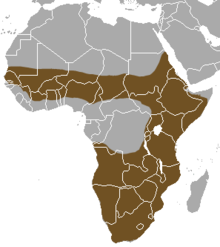| Striped polecat[1] | |
|---|---|

| |
| Taxidermied specimen in the Museo Civico di Storia Naturale Giacomo Doria, Genoa | |
| Scientific classification | |
| Domain: | Eukaryota |
| Kingdom: | Animalia |
| Phylum: | Chordata |
| Class: | Mammalia |
| Order: | Carnivora |
| Family: | Mustelidae |
| Genus: | Ictonyx |
| Species: | I. striatus
|
| Binomial name | |
| Ictonyx striatus (Perry, 1810)
| |
| Subspecies[1] | |
|
(many) | |

| |
| Striped polecat range | |
The striped polecat (Ictonyx striatus), also called the African polecat, zoril, zorille, zorilla, Cape polecat, and African skunk, is a member of the family Mustelidae that resembles a skunk (of the family Mephitidae).[3] The name "zorilla" comes from the Spanish word "zorillo", meaning "skunk", itself a diminutive form of the Spanish "zorro," "fox." It lives predominantly in dry and arid climates, such as the savannahs and open country of Central, Southern, and sub-Saharan Africa, excluding the Congo Basin and the more coastal areas of West Africa.[2][4]
- ^ a b Wozencraft, W. C. (2005). "Ictonyx striatus". In Wilson, D. E.; Reeder, D. M. (eds.). Mammal Species of the World: A Taxonomic and Geographic Reference (3rd ed.). Johns Hopkins University Press. pp. 532–628. ISBN 978-0-8018-8221-0. OCLC 62265494.
- ^ a b Stuart, C.; Stuart, M.; Do Linh San, E. (2015). "Ictonyx striatus". IUCN Red List of Threatened Species. 2015: e.T41646A45212491. doi:10.2305/IUCN.UK.2015-4.RLTS.T41646A45212491.en. Retrieved 11 November 2021.
- ^ Walker, Clive (1996). Signs of the Wild. Cape Town: Struik Publishers. p. 56.
- ^ Estes, Richard (1991). The Behavior Guide to African Mammals: Including Hoofed Mammals, Carnivores, Primates. Berkeley and Los Angeles: University of California Press. p. 429. ISBN 9780520272972.
